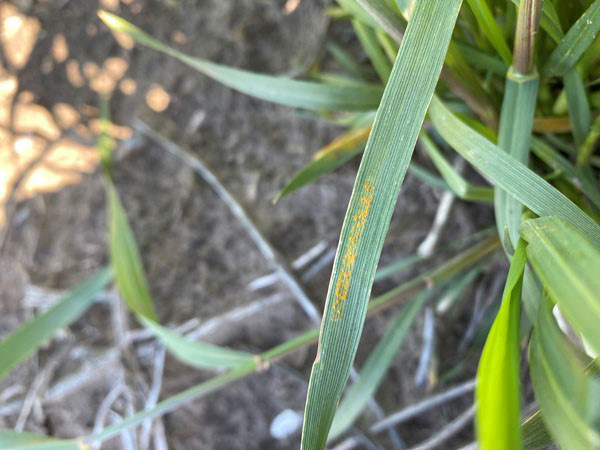The wheat crop is moving quickly and is ahead of schedule in many locations. Now is a critical time to assess the need for a foliar fungicide application. This year, the first stripe rust report was received from Chillicothe, TX, on January 31, where the disease was just starting to take hold. Reports indicated that stripe rust was still active there and in McGregor, TX, in late February. High levels of stripe rust have been reported in multiple locations in Oklahoma, with severe disease noted in Altus, OK.
In Kansas, stripe rust was first detected in Sumner County on April 9, 2024, and since then, low levels have been detected in 14 counties (Figure 1) despite statewide dry conditions. Incidence remains low in most locations. Real-time observations can be seen here: https://wheat.agpestmonitor.org/stripe-rust/. Regions in the state that are expecting high moisture over the coming days may be at risk for more severe disease development.

Figure 1. Distribution of stripe rust in Kansas as of April 25, 2024. Map is based on observations from K-State Research and Extension, crop consultants, and wheat producers in the state. Real-time stripe rust progress can be monitored here: https://wheat.agpestmonitor.org/stripe-rust/.
Stripe rust is most yield-limiting when it advances to the upper canopy, particularly the flag leaf. The risk of stripe rust causing yield loss is a function of several things, including:
- Timing of first local disease detection in relation to crop growth stage (earlier detection can sometimes mean higher risk)
- Weather conditions: specifically, moisture and relative humidity
- Variety genetics: varieties with better resistance ratings will generally have lower levels of yield loss than those that are more susceptible. A good rule of thumb is that varieties that rate 3 or better for stripe rust will not benefit from a fungicide application. Variety ratings can be found in the K-State Wheat Variety Disease and Insect Rating Guide: https://bookstore.ksre.ksu.edu/pubs/MF991.pdf
Stripe rust risk assessment for the coming weeks
It is clear that stripe rust is active in the state, but dry weather has kept the disease largely at low levels. We also know that there is a high incidence of stripe rust in several locations in Oklahoma, meaning that there is no shortage of inoculum blowing in from our south. Areas that are forecasted to receive moisture over the coming days are at higher risk for stripe rust to take hold at economic levels. As a reminder, it takes 7-14 days for symptoms to develop after stripe rust infection events. Because of this, it may be a week or two before we know how bad the disease is after the rain that is forecasted in the upcoming days.
Deciding on a fungicide application to control stripe rust
Scouting is a critical first step for stripe rust control. Stripe rust can be identified by characteristic orange lesions that form in straight lines on mature plants (Figure 2). The orange spores will be easily dislodged when you run your finger over a stripe rust pustule.

Figure 2. Classic symptoms of stripe rust. Photo by Kelsey Andersen Onofre, K-State Research and Extension.
Fungicide applications are most beneficial when the level of disease in the field is below 10% severity. University research has demonstrated that applications that protect the fully emerged flag leaf (between Feekes 8 and Feekes 10) are most effective. See this K-State publication for additional information about growth staging wheat: https://bookstore.ksre.ksu.edu/pubs/MF3300.pdf. Applications applied prior to flag leaf emergence will not adequately protect the flag leaf or the head but can keep diseases from progressing up the canopy. Always check and follow product label recommendations to ensure full compliance with growth-stage limitations and pre-harvest intervals.
When stripe rust is severe, we can expect 10-15% yield protection from a fungicide application. Fields with higher yield potential should be prioritized for applications, as drought-stressed wheat with lower yield potential risks not breaking even from a fungicide application even if conditions are favorable from disease.
Many products are rated very good or excellent for stripe rust control. Ratings for individual products can be found here: http://www.bookstore.ksre.ksu.edu/pubs/EP130.pdf. The products listed in the K-State fungicide efficacy publication will generally provide at least 14-21 days of protection. This can vary between products and is also influenced by environmental conditions.
The decision to apply a fungicide should be balanced against the crop’s yield potential and the current wheat grain price. Fields with the potential to yield greater than 40 bu/a should be prioritized for a fungicide application.





